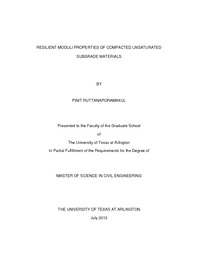
ATTENTION: The works hosted here are being migrated to a new repository that will consolidate resources, improve discoverability, and better show UTA's research impact on the global community. We will update authors as the migration progresses. Please see MavMatrix for more information.
Show simple item record
| dc.contributor.author | Ruttanaporamakul, Pinit | en_US |
| dc.date.accessioned | 2013-03-20T19:11:34Z | |
| dc.date.available | 2013-03-20T19:11:34Z | |
| dc.date.issued | 2013-03-20 | |
| dc.date.submitted | January 2012 | en_US |
| dc.identifier.other | DISS-11791 | en_US |
| dc.identifier.uri | http://hdl.handle.net/10106/11547 | |
| dc.description.abstract | According to the new Mechanistic Empirical Pavement Design Guide (MEPDG) and 1993 AASHTO flexible pavement design guide, Resilient Modulus (MR) has been used extensively as an important material property in structure design of pavement. The modulus is used as the primary input parameter to determine the stiffness parameters and constitutive behavior of pavement components. The system of pavement basically consists of the layers of surface, base, subbase (optional), and subgrade. The compacted subgrade soils supporting pavement structure are typically unsaturated with degrees of saturation varying from 75 to 90%. The effect of unsaturated soil behavior on the mechanical properties of compacted pavement materials become an important variable and need to be considered.The main purpose of this study is to study the resilient moduli properties of compacted and unsaturated subgrade materials and to determine the effect of compaction moisture content, which is related to matric suction of the soils, on the resilient moduli properties. The second objective is to study the use of MEPDG models to calibrate resilient moduli properties either as a function of moisture content or soil suction variables. To accomplish these objectives, soil specimens were prepared at five different moisture content and dry density conditions and tested using conventional resilient modulus testing as per AASHTO T-307 procedure. The basic soil tests such as grain size distribution, Atterberg's limits, and standard proctor compaction were initially performed. Then, the advanced soil tests consisting of soil water characteristic curve (SWCCs), unconfined compressive strength (UCS) test, and conventional resilient modulus test were conducted. The soil suction conditions of the prepared specimens were determined based on the SWCCs information and the compaction moisture content. The test results indicate that compaction moisture content affected the values of resilient modulus of the subgrade soils. The specimens compacted at dry side of optimum moisture content showed higher values of resilient modulus. The testing data were also analyzed with the models provided in MEPDG program. The level 2 input for predicting SWCCs provided in MEPDG gave the predicted SWCCs in similar trend to the measured SWCCs. However, the curves were not quite well matched. Lastly, the modified universal model and the model proposed by Cary and Zapata (2010) were studied and analyzed in detail. The results showed that the universal model is well suited for predicting the resilient modulus of the subgrade soils. However, the resilient modulus values predicted by the model of Cary and Zapata, sometime, showed the higher values than measured results especially, the specimens compacted at 0.8OMC. | en_US |
| dc.description.sponsorship | Puppala, Anand | en_US |
| dc.language.iso | en | en_US |
| dc.publisher | Civil & Environmental Engineering | en_US |
| dc.title | Resilient Moduli Properties Of Compacted Unsaturated Subgrade Materials | en_US |
| dc.type | M.S. | en_US |
| dc.contributor.committeeChair | Puppala, Anand | en_US |
| dc.degree.department | Civil & Environmental Engineering | en_US |
| dc.degree.discipline | Civil & Environmental Engineering | en_US |
| dc.degree.grantor | University of Texas at Arlington | en_US |
| dc.degree.level | masters | en_US |
| dc.degree.name | M.S. | en_US |
Files in this item
- Name:
- Ruttanaporamakul_uta_2502M_117 ...
- Size:
- 3.124Mb
- Format:
- PDF
This item appears in the following Collection(s)
Show simple item record


